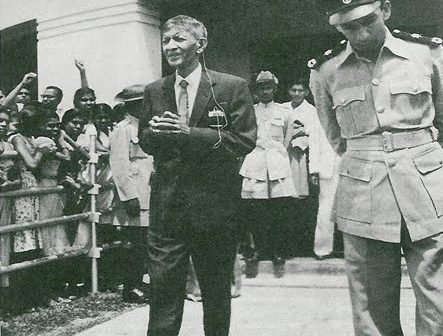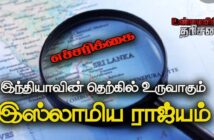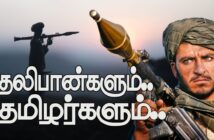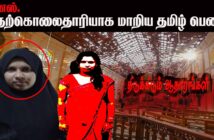- 1972 republican constitution repealed safeguards
- Radicalisation of struggle
- Demand for Eelam
- 1977 general election mandate
- Tamil nation born out of oppression
- International Law supports Tamil demand
- Practical need for constitutional formula for secession
The Tamil Eelam concept first came into political currency in 1959, when in the aftermath of the ‘Sinhala-only’ official language law of 1956, the 1958 abrogation of the ‘Bandaranaike-Chelvanayakam Pact’, the Sinhalese riots of 1958, the ‘Emergency-1958’, the stationing of a permanent army unit in Jaffna and the detention and incarceration of all Tamil F.P.M.Ps in 1958, C. Suntheralingam M.P. for Vavuniya formed the Eela Tamil Ottrumai Munnani (Unity Front of Eelam Tamils) and called for a ‘Eela Tamil struggle for independence’.
In a booklet, published the same year, Suntheralingam wrote:
“In the history of Ceylon.. the Eela Tamils never lost their kingdom entirely, except for two short periods of 16 and 6 years, while for much longer periods Tamil kings have ruled over all Ceylon, history is repeating itself and must indeed repeat itself, adapted to modern conditions. When dharma decays and adharma prospers providence intervenes to destroy the wicked and to protect the weak. That ear has dawned once more in Ceylon, Will the Ela Tamils in this hour of danger and disaster to their nation, show their worth and their valour? Will they do their duty, unite as brothers… and join in the Eela Tamil struggle for independence?”
Suntheralingam’s call for the struggle for the independence of Eelam made in 1959, did not strike any responsive note or popular interest among the Tamils in the sixties.
1972 republican constitution repealed safeguards
It came into public focus when a feeling of the irrevocable end of the road came into the minds of the Tamils when the United Front government under Prime Minister Sirimavo Bandaranaike, in 1972 repealed the independence constitution. With the repeal went the entrenched and inviolate section 29 anti-discriminatory safeguards, which the Privy Council in 1964 stated was “the solemn balance of rights between the citizen of Ceylon, the fundamental condition on which inter se they accepted the constitution and are therefore unalterable under the constitution.”
The Republican constitution, which replaced the independence constitution, consolidated in constitutional provisions all the gains the Sinhala-Buddhists had made in asserting their supremacy and so excluding the Tamils from any power sharing.
It emphasized the rejection of Tamil demands for federal autonomy, regional devolution of powers, and Tamil as the official language of north and east, in these provisions: “The Republic of Sri Lanka is a Unitary State”(Art 2), “The National State Assembly may not abdicate, delegate or in any manner alienate its legislative power, nor may set up an authority with any legislative power, other than the power to make subordinate laws” (Art. 45(1)),”The Official Language of Sri Lanka shall be Sinhala as provided by the Official Language Act. No. 33 of 1956″ (Art. 7) and “The Republic of Sri Lanka shall give to Buddhism the foremost place and accordingly it shall be the duty of the state to protect and foster Buddhism” (Art. 6).
To underscore the rejection of the Republican constitution by the Tamils and in response to the mounting clamour from them to back Tamil equality or withdraw from the unitary state, Chelvanayakam, the F.P leader resigned his seat in the House and demanded a by-election to test the acceptability of the new constitution by the Tamil people. On winning the by- election held more than two years later, Chelvanayakam declared:
“Throughout the ages the Sinhalese and Tamils in the country lived as distinct sovereign people till they were brought under foreign domination. It should be remembered that the Tamils were in the vanguard of the struggle for independence in the full confidence that they also will regain their freedom. We have for the last 25 years made every effort to secure our political rights on the basis of equality with the Sinhalese in a united Ceylon. It is regrettable fact that successive Sinhalese governments have used the power that flows from independence to deny us our fundamental rights and reduce us to the position of a subject people. These governments have been able to do so only be using against the Tamils the sovereignty common to the Sinhalese and the Tamils. I wish to announce to my people and to the country that consider the verdict at this election as a mandate that the Tamil Eelam nation should exercise the sovereignty already vested in the Tamil people and become free. On behalf of the Tamil United Front, I give you my solemn assurance that we will carry out this mandate.”
Radicalisation of struggle
With Prime Minister Mrs. Bandaranaike and her United Front Ministers constitutionally defining the exclusion and separateness of the Tamil people and holding them subjugated in their own Tamil territory by the use of coercive force, Tamil politics became radicalised by the intervention of the young Tamils who suffered incarceration and torture and had been released from police detention without any charges.
Demand for Eelam
Amidst the fast growing insecurity for the Tamils, the Tamil political leadership formed the Tamil United Liberation Front (TULF) in 1976, and at its inaugural convention, presided over by Chelvanayakam resolved to restore and reconstitute the state of Tamil Eelam. Their resolution stated.
“The first National Convention of the Tamil Liberation Front, meeting at Pannakam (Vaddukodai constituency), hereby declares that the Tamils of Ceylon, by virtue of their great language, their religions, their separate culture and heritage, their history of independent existence as a separate state over a distinct territory for several centuries till they were conquered by the Armed might of the European invaders and above all by their will to exist as a separate entity ruling themselves in their own territory, are a nation distinct and apart from the Sinhalese and their constitution announces to the world that the Republican constitution of 1972 has made the Tamils a slave nation ruled by the new colonial masters, the Sinhalese, who are using the power they have wrongly usurped to deprive the Tamil nation of its territory, language, citizenship, economic life, opportunities of employment and education and thereby destroying all the attributes of nationhood of the Tamil people. And therefore… this Convention resolves that the restoration and reconstitution of the Free, Sovereign, Secular, Socialist State of Tamil Eelam based on the right of self-determination inherent in every nation has become inevitable in order to safeguard the very existence of the Tamil nation in this country.”
1977 general election mandate
At the 1977 general election, the TULF went to the Tamil people seeking a mandate from them to establish an independent State of Tamil Eelam. Its election manifesto stated to the Tamil people:
“What is the alternative now left to the nation that has lost its rights to its language, rights to its citizenship, rights to its religions and continues day by day to lose its traditional homeland to Sinhalese colonization? What is the alternative now left to a nation that has lost its opportunities to higher education through “standardization” and its equality in opportunities in the sphere of employment? What is the alternative to a nation that lies helpless as it is being assaulted, looted and killed by hooligans instigated by the ruling race and by the security forces of the state? Where else is an alternative to the Tamil nation that gropes in the dark for its identity and finds itself driven to the brink of devastation?
“There is only one alternative and that is to proclaim with the stamp of finality and fortitude that we alone shall rule over our land our forefathers ruled. Sinhalese imperialism shall quit our Homeland. The Tamil united Liberation Front regards the general election of 1977 as a means of proclaiming to the Sinhalese Government this resolve of the Tamil nation…Hence the TULF seeks in the general Election the mandate of the Tamil Nation to establish an independent, sovereign, secular, socialist State of Tamil Eelam that includes all the geographically contiguous areas that have been the traditional homeland of the Tamil-speaking people in the country.
“The Tamil nation must take the decision to establish its sovereignty in its homeland on the basis of its right to self-determination. The only way to announce this decision to the Sinhalese Government and to the world is to vote for the TULF. The Tamil-speaking representatives who get elected through these votes while being members of the National State Assembly of Ceylon, will also form themselves into the National Assembly of Tamil Eelam which will draft a constitution for the state of Tamil Eelam and establish the independence of Tamil Eelam by bringing that constitution into operation either by peaceful means or by direct action or struggle.”
The Tamil people voted in their thousands in the 1977 election and returned 17 TULF Members throughout the north and east. They voted for them primarily as their representatives to the promised proposed National Assembly of Tamil Eelam, which would draft a constitution and “establish the independence of the Tamil Eelam.”
Tamil nation born out of oppression
Tamil separatist nationalism was born of subjugation and oppression and as resistance to it. That nationalism of an oppressed nation cannot be contained by repression and force but will have to flower and consummate in the birth of the new nation-state. The attempts of the Sri Lankan government and its repressive agents to oppress, terrorise and drive the Tamil people as refugees will prove to be ineffectual. The earlier this is realised the better it is for future understanding as equal friends of neighbouring sovereign states.
When the past determinations have brought about the present oppressive system, the future is certainly not going to be within the past or present.
In the face of early repression, the Liberation Tiger movement was born to resist that repression (see below- note 1), and as state repression took genocidal proportions (see below -note 2) the Tiger guerrilla strategy was supplanted by the Tiger regular army to defend the Tamil people and their homelands and achieve Tamil freedom.
International Law supports Tamil demand
The UN international Convention on the Elimination of all forms of Racial Discrimination (G.A. Resolution 2106 of 1966) defines “racial discrimination” as any distinction, exclusion, restriction or preference based on race, descent, colour, or national or ethnic which has the purpose or effect of nullifying or impairing the recognition, enjoyment or exercise, on an equal footing, of human rights and fundamental freedoms in the political, economic, social, cultural or any other field of public life”
The whole of the Sri Lankan state system- political, economic, social, cultural, educational, and every other field of public life is based upon the racial discrimination of the Tamil people. Sri Lanka is a state violative of the UN charter obligations and provisions on human rights.
The UN Declaration on the Granting of Independence to Colonial Countries and Peoples (G.A. Resolution 1514 of 1960) states that “the process of liberation is irresistible and irreversible and all people have an inalienable right to complete freedom, the exercise of their sovereignty.”
In this Resolution, The General Assembly proclaimed “the necessity of bringing to a speedy and unconditional end colonialism in all its forms and manifestations.”
The Declaration stated:
“The subjection of peoples to alien subjugation, domination and exploitation constitutes denial of fundamental human rights, is contrary to the Charter of the UN and is an impediment to the promotion of world peace and co-operation.”
The UN International Covenant on Civil and Political Rights (G.A Resolution 2200 of 1966, ratified by the Sri Lanka government in June 1980) in Article 1 states:
“All peoples have the right of self-determination. By virtue of that right they freely determine their political status and freely pursue their economic, social and cultural development.”
And Article 3 states:
“States Parties to the present Covenant.. shall promote the realization of the right of self-determination and shall respect that right”.
The Tamils are seeking precisely this right to self-determination to which they are entitled according to this UN Covenant, which the Sri Lanka government by ratifying has agreed to promote its realization.
The UN Declaration on the International Status of “peoples” and their Right of Self-Determination (G.A. Resolution 2625 of 1970) states:
“The establishment of a sovereign independent state, the free association or integration with an independent state or the emergence into any other political status freely determined by the people constitute modes of implementing the right of self-determination by that people”.
The Sri Lanka government has not simply been against but openly oppressive of the Tamil people, as a nation and its political, economic and ethno-cultural interest and advancement. As such the Sri Lanka Tamils have no state and are seeking to create their own sovereign state of Eelam in their own homelands based on their right to self-determination.
They proudly announced their desire for self-determination at the 1977 general election and their political right and their resolve for self-determination must be recognized and supported by the UN and Member States.
The Tamil freedom fighters today assert and bear arms in pursuance of their internationally recognized right to self-determination.
Practical need for
constitutional formula for secession
In practical terms, what is now necessary is a constitutional formula for secession.
In this, the Tamil people need the help of the international community, as the oppressor does not recognize its own international obligations. Otherwise, the state of international relations would be seen to one of paralysis and bankruptcy, the inaction dictated by out-dated clichés of ‘Internal affairs’, ‘territorial integrity’, ‘national unity’, etc.
To avoid further unnecessary violence, turmoil and loss of lives, on both sides, it is the right and the duty of the UN and Member-States, to intervene in recognition of their own obligations and the right of the Tamil people to self-determination.
Secession to day to the Tamil people is not a matter of choice but one of ineluctable necessity for Tamil national self-preservation. “Territorial separation when demanded by cohesive groups with a strong sense of separate identity is essential for human dignity.” (Suzuki, Self-determination and World Public Order, 16 Va. Journal of International Law, 779-862 (1976)).
The UN Declaration on the principles of Equal Rights and Self-Determination (G.A. Resolution 2625 of 1970) gives the right of self-determination to peoples within existing independent states when government fail to “conduct themselves in compliance with the principles of equal rights” and when the state does not “represent the whole of the people belonging to the territory without distinction as to race, creed or colour.”
Internal violence has many a time threatened international peace and it must be avoided by the timely intervention of the international community.
Henkin, Pugh, Schachter and Smit, the eminent American professors, in their treatise on INTERNATIONAL LAW set down the present practice of States in regard to demand for secession:
“Demands for territorial separation or autonomy will continue to be made, and under the pressure of particular circumstances they may be supported by external states and by international organizations” (p.212).
Professor Robert Jackson of All Souls College, Oxford, in his study of South-Asian Crisis (Bangla Desh) of 1971, concluded with these words:
“The main lesson of the South-Asian Crisis of 1971 was that the working out of historical antagonisms may prove too strong a force for the diplomacy of the great powers to arrest. The appropriate conclusion may be that it is unwise to invest too heavily in the preservation of states-systems whose future is cast in doubt by the operation of local forces.”
The particular justifiable circumstance of the Tamil peoples separationist demand is that it developed out of the dynamic of national oppression and resistance and has generated its own momentum and it perceived solution. It is a national liberation sui generis and in the words of David Selbourne of Ruskin College, Oxford, it is “a true national question, if ever there was one.”
There is need for enlightened and progressive realization that self-determination necessarily involves attack on existing union, territorial unity and state sovereignty.
But that is for the higher cause of human liberation, human rights and human dignity. The existing state structure cannot be regarded or defended as permanent and immutable in the face of internal colonialism, racial subjugation, genocidal repression, organized programs and massacres of a nation of people. The liberation force of Tamil separatism seeks to achieve for the oppressed and enslaved Tamil people what liberation movements the world over achieved for their people from overseas colonialism. It can be furthered by early recognition and support of Tamil peoples right to secede on the basis of self-determination to establish the state of Tamil Eelam in their own homelands of the north and east Sri Lanka in order to promote, protect and safeguard their life, liberty and pursuit of happiness.
[NOTES (1) The Tiger movement was born in 1972 and at the time of its formation it called itself ‘The Tamil New Tigers’. Later, on 5 May 1976, the organization re-named itself the ‘Liberation Tigers of Tamil Eelam'(LTTE). In an interview given by V. Prabhakaran, leader of the LTTE. to Anita Pratab, which appeared in SUNDAY (News Magazine of India of 11-17 March 1984), Prabhakaran said: “I originally formed the movement with a group of the dedicated youths who sincerely believed that armed struggle was the only way to liberate our people. I named the movement ‘Liberation tigers’ since the Tiger emblem had deep roots in the political history of the Tamils, symbolising Tamil patriotic resurgence. The Tiger symbol also depicts the mode of our guerrilla warfare.”
(2) On 15th of July 1979, after enacting the prevention of Terrorism Ac t(far more draconian than the notorius Terrorism Act of South Africa) and having declared an Emergency in Jaffna and also having despatched the military to the Tamil north under the command of Brigadier Weeratunga, J.R. Jayewardene, the President of Sri Lanka gave a special directive to the Brigadier in these words: ” It will be your duty to eliminate in accordance with the laws of the land the menace of terrorism in all it forms from the Island and more especially from the Jaffna District. I will pace at your disposal all resources of the state. I earnestly request all law-abiding citizens to give their co-operation to you. This task has to be performed by you and completed before the 31st December 1979.” ]




